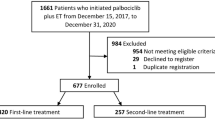Abstract
The Faslodex Investigation of Dose evaluation in Estrogen Receptor-positive advanced breast cancer (FINDER)2 study evaluated the efficacy, safety, and pharmacokinetics (PK) of three fulvestrant dosing regimens. FINDER2 enrolled Western postmenopausal women recurring or progressing after prior endocrine therapy. Primary endpoint: objective response rate (ORR); secondary endpoints: time to progression (TTP), clinical benefit rate (CBR), tolerability, and PK parameters. Patients were randomized to receive fulvestrant: 250 mg/month (approved dose [AD]); 250 mg plus loading dose (loading dose [LD]; 500 mg on day 0, 250 mg on days 14, 28, and monthly thereafter); or 500 mg (high dose [HD]; 500 mg/month plus 500 mg on day 14 of Month 1). Treatment continued until disease progression or discontinuation. 144 patients were randomized: fulvestrant AD (n = 47); LD (n = 51); HD (n = 46). ORRs were: 8.5% (95% confidence interval [CI]: 2.4, 20.4%), 5.9% (1.2, 16.2%), and 15.2% (6.3, 28.9%) in the AD, LD, and HD arms, respectively. CBRs were: 31.9% (95% CI: 19.1, 47.1%), 47.1% (32.9, 61.5%), and 47.8% (32.9, 63.1%) for the AD, LD, and HD arms, respectively. Median TTP (months) was numerically longer for HD (6.0) and LD (6.1) versus AD (3.1). Tolerability was similar across dosing regimens. Steady-state plasma fulvestrant concentrations were predictable and achieved earlier with LD and HD. While there appeared to be a trend toward improved efficacy with HD and LD versus AD, no significant differences could be shown. A parallel study (FINDER1) has reported similar findings in Japanese patients.



Similar content being viewed by others
References
Wakeling AE (2000) Similarities and distinctions in the mode of action of different classes of antioestrogens. Endocr Relat Cancer 7:17–28
Howell A (2006) Fulvestrant (‘Faslodex’): current and future role in breast cancer management. Crit Rev Oncol Hematol 57:265–273
Howell A, Robertson JFR, Quaresma Albano J et al (2002) Fulvestrant, formerly ICI 182, 780, is as effective as anastrozole in postmenopausal women with advanced breast cancer progressing after prior endocrine treatment. J Clin Oncol 20:3396–3403
Osborne CK, Pippen J, Jones SE et al (2002) Double-blind, randomized trial comparing the efficacy and tolerability of fulvestrant versus anastrozole in postmenopausal women with advanced breast cancer progressing on prior endocrine therapy: results of a North American trial. J Clin Oncol 20:3386–3395
Robertson JFR (2007) Fulvestrant (Faslodex)—how to make a good drug better. Oncologist 12:774–784
Therasse P, Arbuck SG, Eisenhauer EA et al (2000) New guidelines to evaluate the response to treatment in solid tumors. European Organization for Research and Treatment of Cancer, National Cancer Institute of the United States, National Cancer Institute of Canada. J Natl Cancer Inst 92:205–216
Robertson JF, Erikstein B, Osborne KC et al (2004) Pharmacokinetic profile of intramuscular fulvestrant in advanced breast cancer. Clin Pharmacokinet 43:529–538
Chia S, Gradishar W, Mauriac L et al (2008) Double-blind, randomized placebo controlled trial of fulvestrant compared with exemestane after prior nonsteroidal aromatase inhibitor therapy in postmenopausal women with hormone receptor-positive, advanced breast cancer: results from EFECT. J Clin Oncol 26:1664–1670
Robertson JFR, Llombart A, Rolski J et al (2009) Activity of fulvestrant 500 mg versus anastrozole 1 mg as first-line treatment for advanced breast cancer: results from the FIRST study. J Clin Oncol 27:4530–4535
Come SE, Parker LM, wulf G et al (2009) Tolerability and efficacy of 500 mg fulvestrant in postmenopausal women with estrogen receptor (ER)+ advanced breast cancer. J Clin Oncol ASCO Annual Meeting Proceedings 27: (abstr 1050)
Kuter I, Hegg R, Singer CF et al (2007) Fulvestrant 500 mg vs 250 mg: first results from NEWEST, a randomized, phase II neoadjuvant trial in postmenopausal women with locally advanced, estrogen receptor-positive breast cancer. Breast Cancer Res Treat 106:S7 (abstr 23)
Di Leo A, Jerusalem G, Petruzelka L et al (2009) CONFIRM: a phase III, randomized, parallel-group trial comparing fulvestrant 250 mg vs. fulvestrant 500 mg in postmenopausal women with estrogen receptor-positive advanced breast cancer. Cancer Res 69:491s (abstr 25)
McCormack P, Sapunar F (2008) Pharmacokinetic profile of the fulvestrant loading dose regimen in postmenopausal women with hormone receptor-positive advanced breast cancer. Clin Breast Cancer 8:347–351
Sagara Y, Ohno S, Iwata H et al (2009) Three dose regimens of fulvestrant in advanced breast cancer: results from a double-blind, comparative study (FINDER1). In: ASCO breast cancer symposium, San Francisco, CA, USA, October 8–10 (abstr 241)
Acknowledgments
The authors would like to thank Katrina de Saram, PhD, formerly from Complete Medical Communications, who provided medical writing support funded by AstraZeneca. This study was funded by AstraZeneca Pharmaceuticals.
Author information
Authors and Affiliations
Corresponding author
Rights and permissions
About this article
Cite this article
Pritchard, K.I., Rolski, J., Papai, Z. et al. Results of a phase II study comparing three dosing regimens of fulvestrant in postmenopausal women with advanced breast cancer (FINDER2). Breast Cancer Res Treat 123, 453–461 (2010). https://doi.org/10.1007/s10549-010-1022-9
Received:
Accepted:
Published:
Issue Date:
DOI: https://doi.org/10.1007/s10549-010-1022-9




